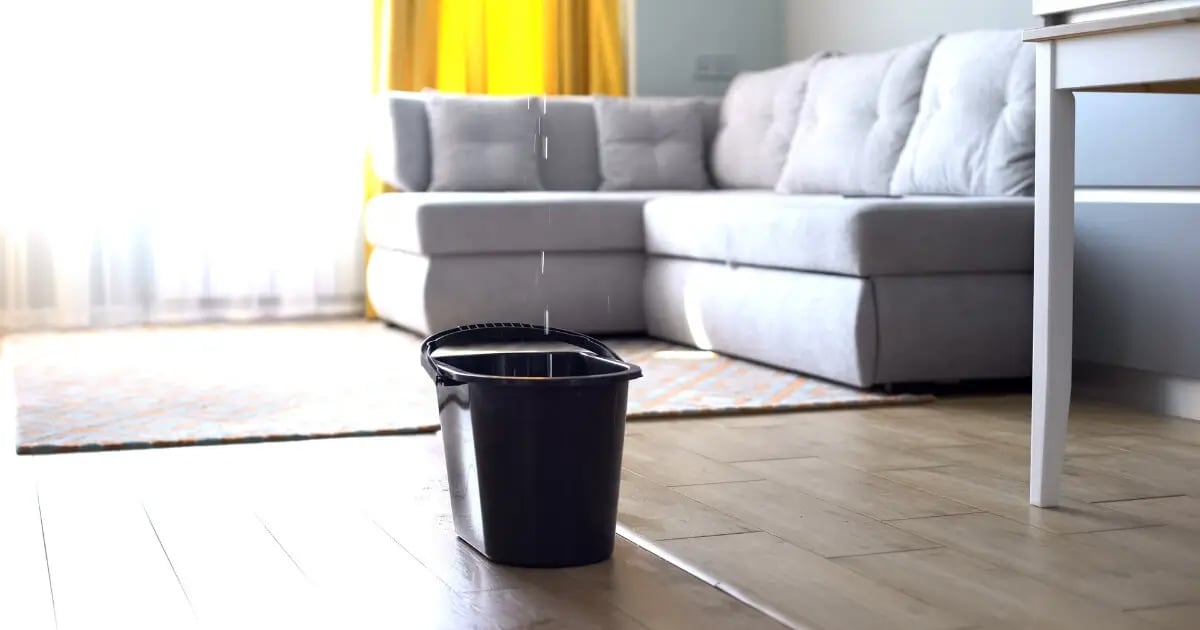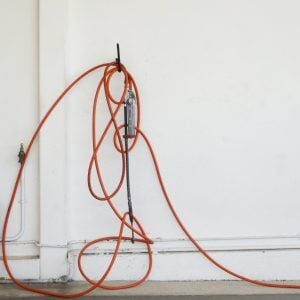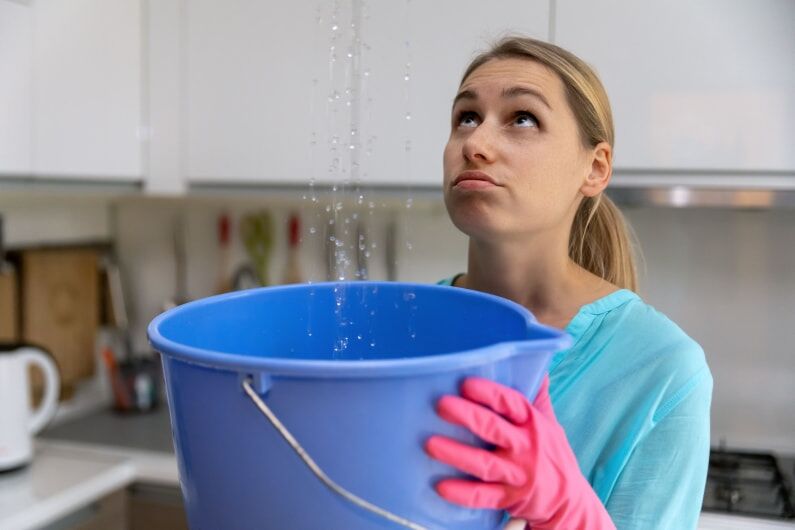Serving MD, DC & VA
10 Tips for Managing Roof Leaks Until You Can Get Professional Help

The first thing to do when your roof leaks is to call a professional roofer to install a new leak-proof roof. Unfortunately, you may not always be able to get help to your home right away.
So, what can you do to stop a roof leak and minimize damage on your own? Capitol Improvements recommends following these 10 easy-to-follow steps until your roofer is able to inspect and install a new roof.
In this article:
Managing Roof Leaks
A leaking roof is nothing to take lightly. Even seemingly minor roof leaks can result in serious water damage down the line. If you notice your roof leaking, take action right away to minimize the damage as much as you can. More importantly, make sure you work with a professional Bowie roofing contractor to fully inspect, identify, and install a new leak-proof roof.
As a homeowner, you might put off replacing that leaky roof for fear of a costly repair bill. With flexible financing options, Capitol Improvements ensures that you can replace your roof quickly and affordably before the leaks create more extensive--and more expensive--damage.
If you notice your roof leaking, don't ignore it! Contact your roofing contractor right away (if you're in the D.C. area, contact us), and follow the 10 steps below to manage roof leaks until help arrives.

1. Minimize Interior Damage
After you’ve called a roofer to schedule a professional repair (or if it's the weekend or after closing time), the first step in managing a leaking roof is minimizing the damage to the interior of your home.
This means rearranging the furniture, removing valuable or cherished items from the area, and covering floors and walls with waterproof materials such as a spare tarp or plastic garbage bags.
Soak up any standing water from the floor before covering the area with your waterproof covering to avoid trapping moisture against the surface. If water from the leaking roof is dripping down an interior wall, you can apply a plastic barrier to the wall, as well.
If you notice the ceiling dipping or bulging as though it is full of water, properly protect the surrounding area and poke a small hole in the ceiling to release the leak. This will help prevent further damage to the surrounding drywall.
Next, place a large bucket or another container beneath the leak to catch falling water. Make sure to surround the container with protective plastic, and don't leave the area unattended for too long. Even a large bucket can fill up faster than you might expect.
2. Investigate the Attic or Crawlspace
If you have access to an attic or crawlspace, grab a flashlight and climb up. You can track the leak within your attic or crawlspace based on where it appears in the ceiling below. However, keep in mind that the way water travels from a leaking roof can be deceptive.
Water from a leaking roof doesn't travel in a straight line. Instead, a roof leak near Washington D.C. (and elsewhere) typically causes water to travel from the damaged roof downwards towards the nearest joint. From there, the leak will find an escape route, where it creates the leak you see in your ceiling. This escape route is usually a weak spot in the ceiling's drywall or the opening for a fixture, such as a vent or ceiling lamp.
This makes finding the cause of a roofing leak in the roof itself difficult, even if you find where the water appears to be entering the attic or crawlspace. But this step can still help you better pinpoint where the water is entering the home. It also gives you the opportunity to create another barrier to stop the water from reaching the ceiling.
To create the barrier, first lay a piece of plywood across the joists within your attic or crawlspace, and place a large bucket on top to catch dripping water. Don’t place the bucket directly on the drywall between joists, as it may break through the drywall when it fills with water. Remember to go up regularly to empty the water!
3. Redirect Leaking Water with a Bottle Funnel

If you’d rather not deal with emptying a bucket or other container every couple of hours, a bottle funnel can redirect water outside the house, instead. The bottle funnel solution can be used inside the home, where the leak is entering through the ceiling, but is best applied within the attic to most effectively deter water damage.
To create a roof leak funnel, grab an empty plastic jug or large bottle. Cut the bottle in half so that you have a wide opening on one end and the bottleneck on the other.
Next, grab a hose. It will need to be long enough to reach from the location of the roof leak to the nearest window or exit.
Using duct tape or another strong adhesive, attach one end of the hose to the bottleneck end of your funnel. Using the same strong adhesive, position the wide end of the funnel over the leak and attach it securely in place.
Now, you can place the other end of the hose outside via a window or door, and the water should flow through the funnel safely out of the house.
4. Examine from a Distance
After you’ve temporarily minimized the damage to your home’s interior, including the attic or crawlspace, it’s time to take a look at the roof from outside of your home.
Again, tracing the source of a leak from the point in the ceiling where water comes through can be difficult. Examining the roof itself can help you connect the dots. You may be able to spot potential problems from close up, or you may need to step back and look at the whole roof.
To do this, you can use binoculars to "zoom in" on your roof from across the street or across the lawn. This is easier and more effective for sloped roofs, since it can be difficult to see the top of your flat roof from the ground.
Signs of damage may be obvious using this method—a tree limb that’s fallen on the roof, or a missing shingle—or you may need to go in for a closer look to examine the cause of the leak.
5. Look for These Causes of Your Roof Leak
If you feel comfortable and confident doing so, the next step is going onto your roof to inspect the area and find the cause of the roof leak.
If you have an especially high-up or steeply-sloped roof, it’s best to manage a leaking roof from ground level and wait until professional help arrives. However, if your roof is relatively low to the ground, and you have the necessary equipment to follow roof safety precautions (see step 10), you may choose to investigate the situation yourself.
Once you’re on top of the roof, look for these potential causes of a leak:
Aged or brittle roofing materials
Roofing materials naturally deteriorate as they age, gradually becoming less and less effective at protecting the home from water damage.
Look for patches of roof that look especially brittle or damaged by age (lifting edges, crumbling materials, melted tar).
Damaged flashing
Metal roof flashing is used at roof joints and transitions where water flows heavily or where absorption may occur. Flashing is an important part of protecting your home from roof leaks, and aged or damaged flashing is a common cause of leaking roofs.
Look for flashing where your roof joins a dormer, where the chimney travels through the roof, and around the edges of features like skylights and vents.
Examine flashing for sections that have slid out of place due to missing nails, or portions that have lifted because of dried and cracked caulking.
Missing or lifted shingles
If you have a shingled roof, it may be susceptible to damage from strong winds and heavy rain or snow. Severe windy weather can lift a weak shingle and even tear it off completely.
If a shingle is lifted or missing, your roof is susceptible to water absorption in that spot.
While examining your roof, look at your shingles to make sure they’re each laying flat and flush, and that none of them are missing.
Pooling water on flat roofs
If you have a flat roof, your roof is made of waterproof membranes, and it is positioned at a slight angle (usually about a 1% slope) to help shed water.
However, waterproofing materials can age or become damaged, causing water to shed less effectively.
If you have a flat roof, pooling or standing water can be a major cause of a leaking roof.
Debris on the roof
Another way windy and inclement weather can cause roof leaks is by creating a buildup of litter on the roof. Leaves, pine needles, and twigs can create a layer of debris that traps water against the roof surface and eventually causes it to seep through. Look for piles of debris on your roof that could be causing a leak.
Additionally, look for larger debris—like fallen tree limbs—that could have punctured or weakened roofing materials upon impact.
Blocked gutters
Your roof’s gutters are critical in keeping water from pooling and soaking through roofing materials. They keep rain and melted snow flowing in the right direction—downwards off the roof.
If your gutters are blocked by leaves or other debris, water won’t be able to escape and may cause a roof leak.
Garage Leaks
Another place you might find leaks inside your home is the garage. Managing roof leaks in your garage is a crucial aspect of home maintenance that often goes unnoticed until significant damage occurs. A leaky garage roof can lead to a host of problems, including structural damage, mold growth, and deterioration of stored items such as tools, vehicles, and seasonal decorations are at risk of damage or destruction due to moisture exposure.
Mold and mildew resulting from persistent dampness can pose health hazards, especially for individuals with respiratory issues. Additionally, the presence of water can attract pests, further complicating the situation.
The impacts of a neglected leak can be far-reaching. According to experts at A1 Garage Door Service, it’s essential to regularly inspect your garage roof for signs of wear and tear, especially after severe weather conditions. A leaking roof can even affect how your garage door operates, and put extra wear on the system which would require you to need garage door repair or even a new garage door much sooner than you typically would.
Regular maintenance, such as clearing gutters and downspouts, can prevent water accumulation and potential leaks. In the long run, investing in the health of your garage roof not only protects your possessions but also maintains the overall value and safety of your property.
6. Clear Away Leaves and Small Debris

If you notice any leaves or other small debris piling up on your roof or blocking gutters, gently sweep the debris off the roof, or reach into the gutter to dislodge the blockage.
Make sure to tend your roof and gutters carefully, as aggressive sweeping or shaking of gutters can cause even more extensive damage. This is especially important as you prepare your roof for winter.
7. Remove Fallen Tree Limbs
Next, if you notice large fallen tree limbs, carefully remove the large debris while paying attention to the potential damage underneath. You will need to cover any holes or areas of damage caused by the fallen limb.
You may not always be able to remove large tree limbs or debris on your own, and that's OK. Some roof debris will need to be broken down into smaller pieces, which is best left to the experts.
If a tree limb cannot be removed safely--for example, if you can't lift the limb without becoming destabilized, or if moving the limb could cause more damage to the roof--simply cover the area as best you can (see step 9) to prevent further water from entering through the roof.
8. Sweep Away and Soak Up Standing Water
If you find an area or multiple areas of pooling or standing water on your flat roof (or low-sloped roof), carefully sweep water downwards off the roof. Remember to use a soft broom and not sweep too aggressively, especially if you have a flat roof that can be easily damaged by scratching and gouging.
Be mindful not to step or put pressure on the area where water has been pooled, as it may be weakened.
To further reduce potential water damage, you can use a mop or towels to soak up any remaining pooled water.
9. Use a Tarp or Plastic Sheet to Cover the Area
Whether you find a damaged shingle, pooling water on the roof, or a fallen tree limb, you’ll need to repair the area temporarily until help can arrive. The simplest and most effective way to do this on your own is with a tarp (or a sheet of polyethylene sheeting) and several two-by-four wooden boards.
First, sandwich each side of the plastic sheet between two boards. Nail the two boards together on each side so that the plastic sheet is held firmly in place. You should now be able to pull the sheet tight and set down the boards so that it lays flat.
- If you have a flat roof, simply spread the tarp out evenly across the damaged area with plenty of room on each side. Set down the boards to hold the covering in place.
- If you have a sloped roof, you can place one set of boards (one side of the tarp) over a peak in the roof to anchor the covering in place.
When placing a tarp over your roof to temporarily cover a leak, make sure to do so gently and without putting too much pressure on any one spot on your roof. Do not nail or staple the tarp directly to the roof materials, as this can create further leaks.
Make sure the boards are heavy enough on all sides to hold the sheet in place and prevent wind from lifting the sheet from underneath. Boards that are not firmly in place can be hazardous to both your roof and to your neighbors.
After placing the tarp, you will need to periodically check on the solution—especially if you have a flat roof—to make sure water isn’t pooling within the tarp.
10. Follow These Rooftop Safety Tips

Before going up on your roof to look for the cause of a leak or to temporarily fix a leaking roof, make sure to review and follow these rooftop safety tips.
If you don’t have the tools necessary, do what you can to manage the leak from inside the house and ground level until professional help arrives.
Don’t take risks
If you’re fearful of heights or have a particularly steep and/or high-up roof, or a roof made of slate or tile, it’s best to manage roof leaks as best you can from inside the house and attic without going up on the roof.
Fixing a roof leak isn’t worth the potential damage—to yourself and to your roof—you could cause if you’re not well prepared.
Wait for better weather
When you notice your roof leaking, chances are high that it’s raining or has been raining heavily.
While it can be tempting to go up to the roof immediately to check things out, you should always wait until the weather clears up and is no longer rainy, windy, or showing signs of lightning.
Follow the buddy system
We recommend never going up on your roof alone. If there’s an accident of any kind, you need someone there to help. A partner can also be helpful when you need materials passed up to you from below.
Use your ladder correctly
Make sure your ladder is in good condition. Set it on a firm and level surface. Your ladder should extend at least three rungs above the edge of your roof so that it can be easily accessed on the way down.
Have someone hold the bottom of your ladder while you ascend and descend to help keep the ladder stable. You can also apply tie-down straps from the gutter spikes to the ladder to reduce movement.
Avoid carrying anything up or down the ladder.
Wear the right gear
Any time you go on the roof, you need to wear solid shoes or boots with rubber soles and superior traction to help reduce slipping. In some states, a safety harness is required to work on roofs that are more than 10 feet high. If the sun is out, make sure to also wear a long-sleeved shirt and sunscreen to protect you from damaging rays.
What Happens if You Ignore a Roof Leak?
Knowing how to temporarily repair roof leaks and manage water damage until help arrives is important. But even more crucial is getting the damaged roof fixed by a Bowie roofing professional as soon as possible. Here is what can happen if you choose to ignore a roof leak—even a relatively minor one—instead.
More expensive repairs
Ignoring a leak won’t make it go away. On the contrary: ignoring a roof leak will inevitably mean more expensive repair bills later on, once the damage has become more severe.
Mold
Adding onto those repair bills, ignoring a roof leak can lead to a costly and unpleasant mold remediation process. Mold is not only a hazard to your home, but if ignored, mold exposure can also lead to allergic reactions and illness in both people and pets.
Decreased roof lifespan
Roof replacements are a taxing process and not one that anyone wants to experience too often. While all roofs will have to be replaced at some point, a consistently leaking roof will have to be replaced sooner.
Professional Washington D.C.-Area Roof Leak Management With Flexible Financing

The best way to manage leaks is with the help of roof leak experts. While you can mitigate the damage from a roof leak in the short term, the only way to truly repair a leak is with professional materials and application.
Capitol Improvements is an award-winning residential and commercial roofing provider in the Washington D.C. area with more than 30 years of experience in roof repair. Best of all, we offer flexible financing to help you fix that roof leak right now, rather than later.
Raining this week
It’s a good time to leakproof your roof.
Minor leaks can turn into major issues quickly, don’t wait until you have to replace more than your roof. Request your free quote to quickly get a roof repair or a new leakproof roof.
